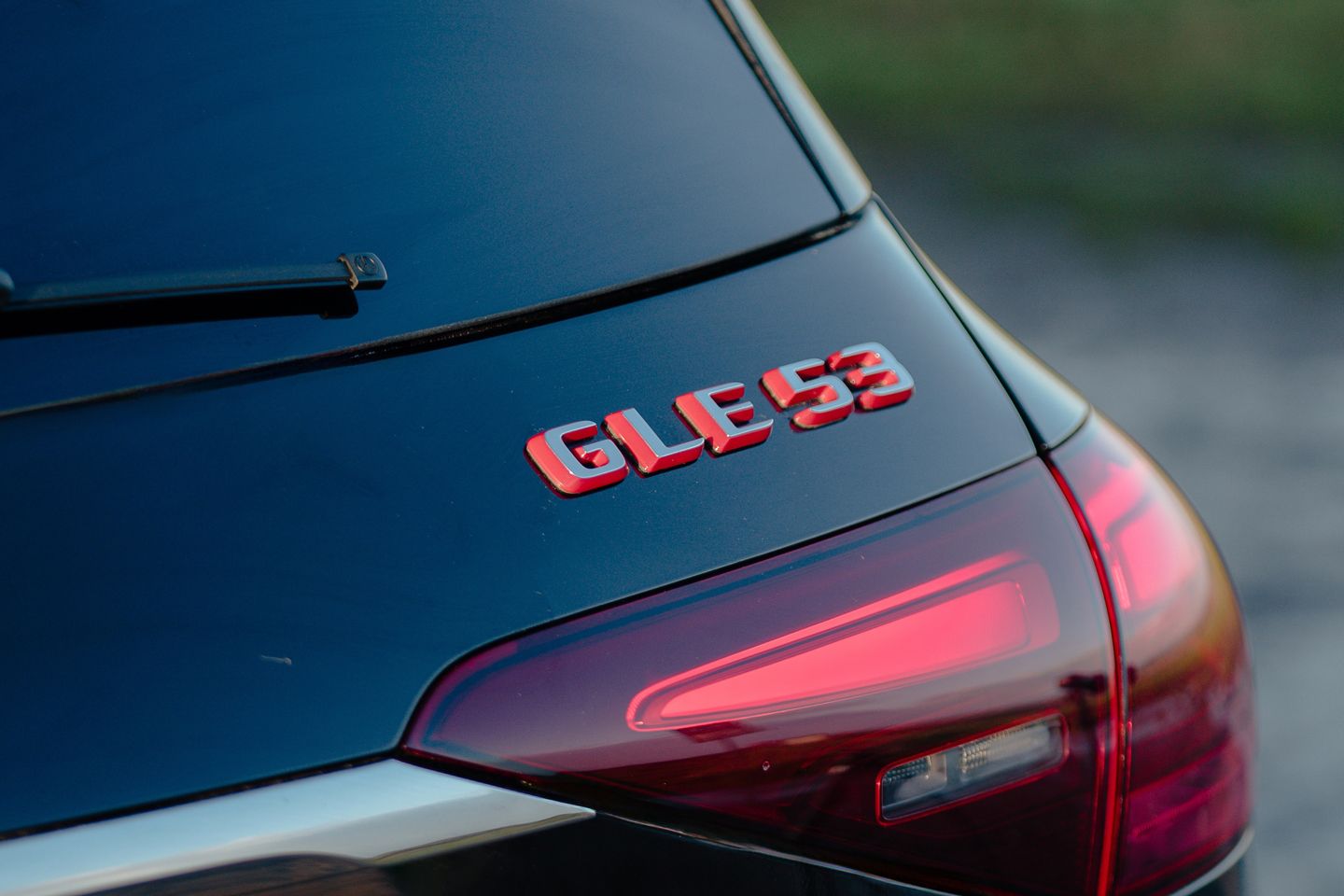
The plug-in hybrid version of the GLE 53 has endured what seems like a bumpy ride before finally arriving in the UK. Revealed back in 2023 – and fundamentally sharing its powertrain with the E53 we drove last summer – it was suggested at the time that the model might not make it to the UK at all, presumably on the basis that it would be redundant what with everyone buying electric SUVs like they were enormous loaves of subsidised sliced white. Fifteen months later, with that forecast in tatters and plug-in hybrids propping up new car sales across the board, the Mercedes-AMG GLE 53 HYBRID has suddenly materialised. Little wonder its maker has felt the need to spell out its distinguishing feature in capital letters.
In fairness, this is also to distinguish it from the other Mercedes-AMG GLE 53 you can apparently still buy, which shares the 449hp six-cylinder petrol engine, but is limited to mild-hybrid status by its familiar 20hp starter generator. The HYBRID, thanks to the presence of a transmission-mounted 136hp e-motor and an underfloor 31kWh battery in the boot, claims a 536hp total output and is claimed to offer around 55 miles of electric range alongside 31g/km combined CO2 emissions. It’ll also do 0-62mph in 4.7 seconds (three-tenths quicker than its sibling, despite being a startling half a tonne heavier on paper) and make it to 90mph on battery power alone. Or 155mph with the straight-six running. In other words, it is Mercedes-AMG’s idea of a plug-in HYBRID should be. So what’s not to like?
Well, to start with, not a whole lot. Despite a recent facelift and some shouty AMG trim addenda (and despite this pre-production car taking its Night Edition status a mite too seriously), the GLE has a curiously anonymous aura when parked up – probably because the W167 model has been around since 2018 and its lineage stretches all the way back to the positively ancient ML. So while it doesn’t want for new tech inside or a general feeling of modernity, the ambience and architecture – heavy on air vents and (for 2025) physical switchgear – is curiously old-fashioned. Which isn’t necessarily a bad thing. A G-Class it manifestly isn’t, yet with shortcuts for deactivating the lane assist and speed limit warning present and correct on a nicely integrated infotainment screen, there is precious little about the GLE cabin that will exasperate you. That’s a win.


As you’d expect from a plug-in hybrid with meaningful battery range, it doesn’t do much to rile you up when ghosting about the place either. As ever, there’s a limit to the electric motor’s performance relative to the petrol engine, but with 324lb ft of torque to call upon, you’re unlikely to locate it just pottering about town. Which, if you’re happy to set aside the question of what an AMG badge (and its premium) is supposed to confer in these moments, is fine – the GLE mimics a luxury EV well enough for as long as it is able, and Mercedes suggests that a 60kW charger will have it back to 80 per cent of capacity in as little as 20 minutes. Confined exclusively to school-run duties, your child would never know what the engine sounded like.
As it happens, this would probably be the ideal state of affairs. This is not the sort of HYBRID that lends itself to the seamless interaction of power sources once the battery is drained – or not in Comfort anyway, which is the default mode once you’ve reached the limit of silent running. The main problem (if we can call it that) is that the battery is never truly exhausted, and instead continues to function like a beefed-up version of the mild-hybrid on partial throttle openings. This ought to be fine, but because it has access to more power, the GLE insists on dutifully shutting down the engine when it assumes it isn’t needed – which, by Mercedes reckoning, is virtually all the time you’re not accelerating very purposefully.
Now, if the baton-passing between e-motor and awakening straight-six were as smooth as a Jamaican 4x100m team in mid-flight, this arrangement would be acceptable – and around town, it’s generally okay – but when you’re moving between mundane A road speeds, the transition from battery energy to petrol power is not just tediously obvious, there is also a sufficient half-second lull between the two to make the pace of your progress seem momentarily disconnected from the accelerator pedal. Which is not just irksome in a ‘why can’t things be perfect’ kind of way, but also about as appropriate to a 536hp Mercedes-AMG as it would be if you replaced the Jamaican team’s baton with a half-empty plastic cider bottle.


Admittedly, this is less of a concern at higher speeds (where the engine isn’t quite so adamant about switching off) and you can squelch the problem entirely by driving everywhere in Sport mode, where the always-on engine and e-motor combine from the get-go. The presence of the latter at low revs means the M256 unit does without its lag-reducing electric compressor, although with up to 553lb ft of torque available, the six-pot doesn’t take very long relocate its likably punchy delivery and a good deal more of its raspy soundtrack. The only downside here is that the nine-speed MCT, usually so adept at selecting the appropriate cog, is inclined to hang onto intermediary ratios like you were Colin McRae on the RAC. Fine if you really are flat out; less good if you just want to push on a bit.
You could change gears for yourself, of course – but the HYBRID never seems particularly suited to spirited paddling in the manner of, say, a Jaguar F-Pace SVR or a high-spec Porsche Cayenne. Which is a shame, because it turns out Mercedes-AMG has done a good job of nailing the car’s air-suspended chassis settings. To appropriately contain its eye-popping 2.8-tonne kerbweight, the manufacturer has added passive stabilisers to both axles, installed new stop buffers in the front struts and upgraded the dampers at the back. Assuming you appreciate a well-judged compromise between plush ride comfort and positive body control, the updated hardware pays real dividends: the plug-in GLE never seems less than heavy and nor does it convincingly shrink around you, but it is easily assured enough for you to go very quickly indeed without sacrificing the sort of long-wave absorbency that makes a large SUV vaguely appealing in the first place.
Dial it up to Sport+ – eminently usable on UK roads – and you’ll locate sufficient go-faster wallop to finally justify the AMG label, even if fuel consumption at this point inevitably descends to the 20-something-MPG that makes you question the advantage of the unavoidably hefty HYBRID bit. Ultimately, you’ll need to be convinced of its real-world benefits for two reasons: one, because the model is priced from £94,360 (fractionally more than a similarly powerful Cayenne S E-Hybrid) which is no small amount of money in a crowded premium SUV market. And two, the presence of its mild-hybrid sibling with the same gutsy petrol engine but spared the cumbersome, boot-pilfering battery (630 litres versus 490 litres), means the thought of a much lighter, more practical and dynamically straightforward GLE is probably going to fester – especially if you’ve not got a compelling use case for going HYBRID.
SPECIFICATION | MERCEDES-AMG GLE 53 HYBRID 4MATIC+ NIGHT EDITION PREMIUM PLUS
Engine: 2,999cc, turbo straight-six, 31kWh battery, e-motor
Transmission: 9-speed automatic, all-wheel drive
Power (hp): 536 (system output; engine 449hp, motor 136hp)
Torque (lb ft): 553 (system output; engine 413lb ft, motor 324lb ft)
0-62mph: 4.7 seconds
Top speed: 155mph (limited; 90mph in EV)
Weight: 2,800kg (EU)
MPG: 201.8-217.3
CO2: 31g/km
Price: £101,360 (as tested)

